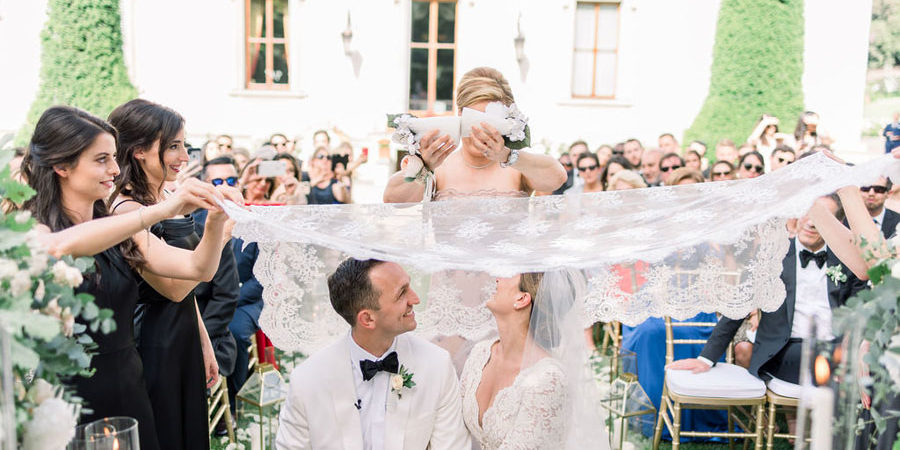Marriage is one of the most significant social events in a person’s life, and wedding traditions vary greatly across different cultures around the world. These traditions reflect the societal and historical values that have accumulated over time. Here is an overview of some wedding traditions in different cultures:
India

In India, wedding traditions vary between castes and regions, but there are some common rituals:
-
Henna:
The bride applies intricate henna designs on her hands and feet, a tradition believed to bring luck and happiness.

-
Sari:
The bride wears a colorful, ornate sari, often in red, which symbolizes joy and good fortune.

-
Mandap:
The wedding takes place under a decorated canopy known as a mandap, where vows and religious rituals are exchanged.

Indian weddings typically include much more than just a ceremony, cocktail hour and reception—they generally include a first day, second day and even third day of celebrations. It’s common for Indian weddings to have multiple prewedding events. The Mehndi ceremony, is one of the most common, and the Sangeet and Haldi are two other events that are likely to take place.
Japan

Japanese weddings combine Shinto traditions with modern practices, Traditional Japanese weddings combine a whole range of elements, from extremely traditional to modern adaptations. Japanese wedding traditions and customs have evolved to combine both Japanese and western culture.
Most traditionally, a Japanese couple would hold their wedding in Shinto style in a shrine. The ceremony is officiated by a Shinto priest. Shinto is the indigenous faith of Japan and is the major religion along with Buddism. Holding a wedding in Shinto style is the most common in Japan at this time.
-
Kimono:
The bride wears a white kimono during the traditional Shinto ceremony, then changes into a colorful kimono for the reception.

-
Shinto Rituals:
The ceremony includes Shinto rituals such as drinking sake from three different cups.

-
Reception:
The couple may wear Western attire, such as a white dress and suit, during the reception.

Nigeria

Nigerian weddings are marked by great diversity due to the country’s ethnic and cultural variety, With an estimated 370 tribes, it’s no wonder that there are dozens of wedding traditions and rituals scattered throughout the country and among Nigerians.
There are several religious groups throughout Nigeria, but the primary religions are Christianity and Islam.
That’s why you’ll see a blend of African and Western cultures in Nigerian wedding ceremonies and receptions.
Nigerian weddings are lively, colorful, and large, no matter what tribe or religion the bride and groom belong to.
-
Traditional Attire:
The couple wears elaborate traditional outfits adorned with beads and vibrant fabrics.

-
Dancing and Singing:
The celebration includes a lot of dancing, singing, and cultural performances.

-
Gift Giving:
Family and friends present gifts to the couple, often including money and symbolic items.

China

Along with the history of more than 5000 years, Chinese wedding has become one of the quintessence in Chinese traditions and been adopted more contemporary features over the generations. China is a vast country with many ethnic groups, that the wedding customs and rituals diverse from regions to regions is such an imaginable thing. However, they still have common celebrating customs.
Chinese wedding traditions include several distinctive rituals:
-
Red:
Red symbolizes luck and happiness, so the bride typically wears a traditional red dress.

-
Tea Ceremony:
The couple offers tea to their elders as a sign of respect and gratitude.

-
Banquet:
A grand banquet is held with family and friends, featuring traditional Chinese dishes.

Greece

Greek weddings are festive events with many traditions stemming from both the Greek Orthodox church and from ancient cultural superstitions.
Although traditions vary from village to village, as well as from region to region, there are a few aspects of a typical Greek wedding that are universal.
Many of these customs are steeped in ancient traditions that influence every last detail of the nuptials, from the engagement rings to the wedding ceremony and onwards.
Greek weddings are rich in Orthodox Christian traditions:
-
Icons:
The wedding ceremony includes religious rituals involving icons and sacred objects.

-
Crown:
The bride and groom wear crowns decorated with flowers or silver during the ceremony.

-
Rice and Sweets:
Rice and sweets are thrown at the couple to symbolize fertility and good fortune.

Italy

Traditional Italian weddings are a delight to watch as every custom and ritual practised signifies the fact that Italians value marriage and marital relationship. Italians are known for their warmth and hospitality, which gets reflected in their wedding festivities, as they make everyone feel a part of the ceremony. The charm of Italian weddings lies in the seamless blend of traditional and modern elements which create a magical experience for the couple, family members, and guests.
Italian weddings are known for their elegance and romance:
-
White Dress:
The bride wears a traditional white dress, and the groom often carries a bouquet of flowers.

-
Golden Rings:
The couple exchanges golden rings as a symbol of love and commitment.

-
Feast:
The celebration includes a large feast featuring traditional Italian dishes and wine.

South Korea

Korean weddings are all about going back to one’s roots. From traditional Korean attire to sharing the “head table” with parents, Koreans weddings encompass all the importance of family and unity.
These days, most couples tend to stick with some of these wedding traditions, but find modern ways to incorporate their western culture as well. For example, during dinner at a Korean wedding reception, you may find a variety of meats and seafood along with traditional items like long noodles and short ribs. And while a cake is also common at Korean weddings, a sticky rice cake called dok is also served.
-
Hanbok:
The bride wears a hanbok, a traditional Korean dress, while the groom wears a similar traditional outfit.

-
Wooden Ducks:
The rituals include the presentation of wooden ducks as a symbol of peace and fertility.

-
Feast:
The celebration includes a grand feast with traditional Korean dishes.

The Importance of Wedding Traditions
Wedding traditions reflect the cultural values and beliefs of different societies and help reinforce cultural and social identity. These traditions also provide an opportunity for family and friends to gather, celebrate, and strengthen social bonds.













Leave a comment